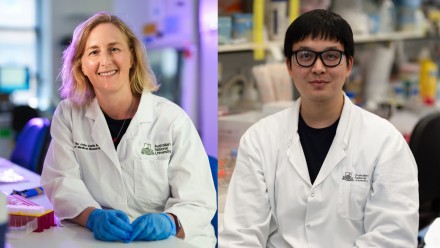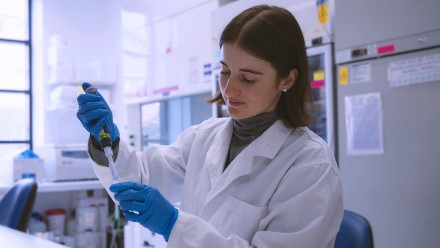Capabilities
Capabilities
The Shine-Dalgarno Centre for RNA Innovation is your gateway to the cutting-edge world of RNA research and technology. As a globally recognised institution at the forefront of RNA innovation, we take pride in our unique benefits, comprehensive services, and a proven track record of success.
Discover the Unique Benefits We Offer
The Shine-Dalgarno Centre for RNA Innovation is a world-renowned centre specialising in researching and using new RNA technologies. We are connected to vital national infrastructure such as the National Collaboration Research Infrastructure Strategy (NCRIS) and collaborate with HealthANSWERS to offer education, research and service excellence in the Australian Capital Territory and New South Wales. We have access to national screening and testing for RNA and hold the capabilities to conduct early phase clinical trials. Our centre has worked with big companies like Moderna, Genentech, Bayer, and Johnson & Johnson and is expanding to ensure that we stay at the forefront of RNA technology and innovation.
Explore our range of Services and Solutions
The Shine-Dalgarno Centre for RNA Innovation offers a diverse range of services and solutions tailored to meet your RNA research needs:
- Understanding RNA Biology Fundamentals
- Supporting RNA Target Discovery
- NEW RNA Tools Development
- Screening RNA Biomarkers and new therapeutics
- RNA Candidate Selection and Optimisation
- Developing new Computational Tools
- Using pre-clinical models for RNA diagnostic and therapeutic validation
- Design and implementation of RNA Manufacturing Solutions
Experience our Proven Success
Our legacy of innovation and impact in the RNA field speaks volumes:
- Innovative Ribosome Footprinting – we developed innovative ribosome footprinting techniques to answer long-standing questions about mRNA translation mechanisms and worked with industry leaders to optimise mRNA therapy.
- Nuclear RNA Processing Mechanisms – our research on nuclear RNA processing mechanisms led to the development of novel RNase H inhibitors.
- Ribosome Biogenesis – we uncovered groundbreaking insights into ribosome biogenesis, which have spurred new treatment paradigms in cancer with two drugs currently in clinical trials.
- Novel Disease-Modifing miRNAs for AMD – our work led to the identification of novel disease-modifying miRNAs as therapeutic targets for age-related macular degeneration (AMD) through the extraction of retinal extracellular vesicles.
- CRISPR Technologies – we’re at the forefront of developing new CRISPR technologies for molecular diagnostics and gene therapy.
- Computational Tools – our computational tools for RNA splicing analysis are widely adopted in basic biology research and biomedical applications.
- Epitranscriptomics– we pioneered the world’s first transcriptome-wide map of an RNA modification, laying the foundation for the burgeoning field of epitranscriptomics.
- mRNA splicing – we’ve demonstrated the critical role of histone variants in mRNA splicing, contributing to a deeper understanding of genetic regulation.
The Shine-Dalgarno Centre for RNA Innovation is your trusted partner in unlocking the vast potential of RNA research. Whether you’re an academic researcher, a pharmaceutical company, or a biotech startup, our unique benefits, comprehensive services and proven successes position us as a leader in the field. Join us on this exciting journey of innovation and discovery, and let’s shape the future of RNA science together.
Partner with us to elevate your success!
Academic Excellence
Novel RNA Therapeutics
 We have developed a program of research around the use, delivery and editing of RNA molecules for the treatment of a range of conditions, including, but not limited to, cancer, autoimmunity and ophthalmology (including age-related macular degeneration). From using extracellular vesicles as delivery mechanisms for non-coding RNA molecules (including miRNA, circular RNA) to developing novel CRISPR-Cas enzymes for RNA editing and innovative small molecule RNA Polymerase I inhibitors, as a group we are advancing novel strategies of biomedical intervention. Drawing on the latest RNA discoveries, this program is set to build an innovative ecosystem where world-class RNA research and technology is targeted to currently untreatable healthcare challenges, independently of traditional disciplinary boundaries.
We have developed a program of research around the use, delivery and editing of RNA molecules for the treatment of a range of conditions, including, but not limited to, cancer, autoimmunity and ophthalmology (including age-related macular degeneration). From using extracellular vesicles as delivery mechanisms for non-coding RNA molecules (including miRNA, circular RNA) to developing novel CRISPR-Cas enzymes for RNA editing and innovative small molecule RNA Polymerase I inhibitors, as a group we are advancing novel strategies of biomedical intervention. Drawing on the latest RNA discoveries, this program is set to build an innovative ecosystem where world-class RNA research and technology is targeted to currently untreatable healthcare challenges, independently of traditional disciplinary boundaries.
See the full list of projects
RNA Sensor and Point of Care Diagnostics
 We also have a molecular diagnostic research program centred around the detection of RNA molecules, biomarkers for diseases. Using CRISPR-Cas gene editing technologies and/or novel RNA biosensors, we are building the next generation of molecular diagnostic tools for point of care diagnostics and a research capability to diagnose and prevent diseases.
We also have a molecular diagnostic research program centred around the detection of RNA molecules, biomarkers for diseases. Using CRISPR-Cas gene editing technologies and/or novel RNA biosensors, we are building the next generation of molecular diagnostic tools for point of care diagnostics and a research capability to diagnose and prevent diseases.
Computational capabilities
 The Centre has developed computational tools that enable the identification and high-throughput measurement of RNA molecules using the latest technologies, including long-read sequencing, single cell sequencing, and spatial transcriptomics. Our Computational Biology research also develops Machine Learning approaches to uncover novel RNA therapeutics and diagnostic markers in cancer and other diseases.
The Centre has developed computational tools that enable the identification and high-throughput measurement of RNA molecules using the latest technologies, including long-read sequencing, single cell sequencing, and spatial transcriptomics. Our Computational Biology research also develops Machine Learning approaches to uncover novel RNA therapeutics and diagnostic markers in cancer and other diseases.
Facilities
The Shine -Dalgarno Centre for RNA Innovation stands on the foundation of essential core facilities and research services, all conveniently situated within the dynamic medical research precinct at ANU. These facilities are integral to our mission and are bolstered by the generous support of the Australian Government National Collaborative Research Infrastructure Strategy (NCRIS), and given their close proximity, these facilities seamlessly enable every aspect of our research journey, from initial testing and screening, all the way through to comprehensive data analysis and secure storage.
ANU Centre for Therapeutic Discovery

The ANU Centre for Therapeutic Discovery (ACTD) funded by the ANU, Australian Cancer Research Foundation (ACRF) and ACT Health, is a high-tech facility for high-throughput screening, biomarker and therapeutic discovery. This state-of-the-art facility uses robotics and liquid handling to streamline experimentation and speed up drug discovery and development for industry use. Find out more. @ANU_Therapeutic
Biomolecular Resource Facility
 The ACRF Biomolecular Resource Facility (BRF) is a sequencing technology hub with a strong focus on supporting RNA biology. The facility has a number of specialists to provide service on a fleet of short read and long read sequencing platforms, including the Illumina NovaSeq6000 and the Oxford Nanopore Technology PromethION. RNA services include RNA-seq, single cell RNA-seq with phenotypic feature barcoding, bisulfite RNA-seq, sequencing native RNA strands or long read mRNA transcripts. Find out more. @ANUbiomolecular
The ACRF Biomolecular Resource Facility (BRF) is a sequencing technology hub with a strong focus on supporting RNA biology. The facility has a number of specialists to provide service on a fleet of short read and long read sequencing platforms, including the Illumina NovaSeq6000 and the Oxford Nanopore Technology PromethION. RNA services include RNA-seq, single cell RNA-seq with phenotypic feature barcoding, bisulfite RNA-seq, sequencing native RNA strands or long read mRNA transcripts. Find out more. @ANUbiomolecular
Centre for Computational Biomedical Sciences
The John Curtin School of Medical Research is home to the Centre for Computational Biomedical Sciences (CCBS), consisting of more than 30 researchers and technicians all closely collaborating across various experimental platforms. The Centre includes the ANU Bioinformatics Consultancy (ABC), which provides consultation and support across a wide range of bioinformatics requirements, from complex data analysis and management to experimental design to ensure statistical rigour. The ABC performs both custom scripting and analysis as well as pipeline development for bioinformatics, such as RNA expression analysis and single cell sequencing. Find out more. @CCBS
National Computational Infrastructure
 The National Computational Infrastructure (NCI) is Australia’s leading high-performance data, storage and computing organisation, which provides expert services to all areas of science, government and industry. Through this collaboration between CCBS and NCI, we are able to use these services for our high-end computational requirements across our research programs and core facilities. Find out more. @NCInews
The National Computational Infrastructure (NCI) is Australia’s leading high-performance data, storage and computing organisation, which provides expert services to all areas of science, government and industry. Through this collaboration between CCBS and NCI, we are able to use these services for our high-end computational requirements across our research programs and core facilities. Find out more. @NCInews
The Australian Phenomics Facility
 The Australian Phenomics Facility (APF) specialises in the development, characterisation, housing and archiving of mouse models of human disease. The APF has an experienced team of genomics and bioinformatics specialists that focuses on generating mouse models of disease and phenotypic characterisation of mouse strains. The APF is the home of the Australian Phenome Bank, a centralised repository of genetically modified mouse strains and strain information used in Medical Research in Australia. The APF also provides support with colony import/export and management, in vitro fertilisation and cryopreservation of strains, exome and whole genome sequencing service packages tailored specifically to the research application. Find out more.
The Australian Phenomics Facility (APF) specialises in the development, characterisation, housing and archiving of mouse models of human disease. The APF has an experienced team of genomics and bioinformatics specialists that focuses on generating mouse models of disease and phenotypic characterisation of mouse strains. The APF is the home of the Australian Phenome Bank, a centralised repository of genetically modified mouse strains and strain information used in Medical Research in Australia. The APF also provides support with colony import/export and management, in vitro fertilisation and cryopreservation of strains, exome and whole genome sequencing service packages tailored specifically to the research application. Find out more.









